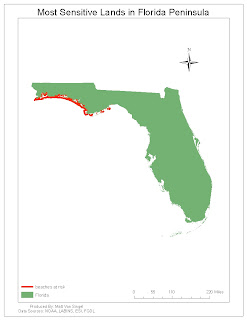Matt Van Singel
A Plan for the Allocation of Funds to Accommodate Increasing Incidence of Asthma in the Bay Area.
Introduction
Figure 1: Base map showing annual hospitalization rates for asthma related illnesses per 10,000 people in the Bay area
California is operating in a financial crisis that is currently being exacerbated by increasing environmental stressors. Over the last decade the San Francisco Bay area has seen a steady rise in hospital admittance rates due to asthma related illnesses, most likely due to pollution. The two primary causes of poor air quality in the Bay area are particulate matter (PM) and ozone. By tracking these two parameters we would theoretically be able to predict where asthma suffers are likely to experience pollution-induced flare-ups. Once we calculate these areas of concern we can derive which hospitals would be in the target area and thus provide the necessary staff and supplies to treat the increasing amounts of asthma patients.
Identifying a Target Area
It is important to asses where the funds will be directed to help assist people in need. Analyzing areas of uninsured and other poverty indicators will allow for agencies to allocate money to specific areas. As seen in Figure 1 on the top image the map shows areas of uninsured in dark blue and dots to indicate high areas of unemployment. In Alameda County the percent uninsured is 13%-15% and also houses a high unemployment rate at 45%-60% of the total population. This county would be the area of greatest need based on these indicators alone and would thus be a prime benefactor of government aid.
Figure 1: Shows the relationship between several variables including insured vs. uninsured and on the lower maps with uninsured vs. Hispanic populations and uninsured vs. African American populations.
The next area of study to determine which area would be in greatest need would be that of ozone and particulate matter. Determining which areas are at highest exposure would allow for further analysis of a specific area and demographic. In Figure 2 the top image displays the total number of individuals per 10,000 people hospitalized for an asthma related illness as a percent of total annual hospitalizations. Through this data it is clear to see Alameda County displays the highest percentage of hospitalized individuals at 17%-21% which Solano, Contra Costa and San Francisco counties hospitalizing 13%-17%. The other two maps in Figure 2 both illustrate the percent of asthma related hospitalizations compared to Hispanic and African American Populations. The map on the lower left shows the correlation between asthma hospitalizations and Hispanic population which shows a weak correlation. The map on the lower right shows a similar illustration with African American populations showing a very strong correlation. Through this analysis it was determined that the African American population in Alameda County would be the most 'at risk' population to particulate matter from surrounding pollution sites.
Figure 2: Shows the percentage of individuals hospitalized due to asthma related illness and also correlates this data to Hispanic and African American populations.
The final aspect that needs to be considered in the search for the target area is where the particulate matter and ozone concentrations are highest. This data was obtained from air quality monitoring stations located throughout the San Francisco metro area. Monthly maximum and averages values are recorded through these sites and listed online for public access. Figure 3 shows the base map of hospitalization incidence per 10,000 individuals on the top map. The lower left illustration shows the very strong correlation between atmospheric particulate matter and incidence of hospitalizations due to asthma related illnesses. This correlation is centered in Alameda County with high particulate matter counts in the surrounding counties as well. The lower right illustration of Figure 3shows the concentration of ozone compared to hospitalization rates. While the correlation is not as strong there is still evidence to support such a claim.
Figure 3: Shows the rate of hospitalized individuals per 10,000 compared to ozone and particulate matter concentrations from data obtained through the air quality monitoring stations in the Bay area.
Examining the Target Area: Alameda County
Figure 4: shows the Euclidian distance from each hospital with the highest African American populations in yellow along with each pollution site.
After it was determined that African Americans in Alameda County were the most at risk demographic in the Bay area further analysis was necessary to determine what hospitals would need increases in staffing and supplies. Through this section ArcGis was utilized to help locate potential areas asthma sufferers would be most likely to experience symptoms. This was done by mapping all area hospitals and creating a Euclidian distance around each location, then separating the highest concentrations of African Americans for comparison. Figure 1 shows the Euclidian distance from each hospital with the highest African American populations in yellow and each pollution site in black circles along with major roads in the area.
Figure 5
Once all data was input into ArcGis further analysis could be performed. All main data layers were reclassified to best portray the information then ArcMap was used to create a new program for which to analyze the data. Each layer was put into a weighted overlay and a map product was output from the created program (Figure 5). Figure 5 shows the areas of overlap for pollution sites and hospital locations along with major roads and highest concentrations of African Americans. The areas in red and blue are the area of highest concern while purple is of lesser concern. Through this map product it can be determined that Alameda Hospital, Highland General Hospital and Booth Memorial Hospital are the three hospitals in highest need of staffing and supplies to treat increasing rates of hospitalization due to asthma related illnesses.


















